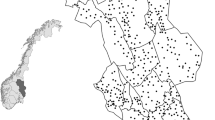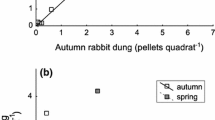Abstract
Swamp rabbits (Sylvilagus aquaticus) are bottomland hardwood forest specialists that may serve as useful indicators of ecosystem health. However, no studies have assessed the influence of both microhabitat and macrohabitat variables on relative abundance of swamp rabbits. To address this gap in the literature, we assessed the influence of landscape- and stand-level habitat variables on relative abundance of swamp rabbits in 29 floodplain forest sites in southern Illinois during 2006–2007. Swamp rabbits were detected at 69% of the sites surveyed. The median contiguity index of the landscape (a measure of patch size and spatial connectedness), the range in contiguity index of upland habitats, and tree stump density were positively and moderately related (w +[i] = 0.381–0.475) to relative abundance of swamp rabbits. Our results emphasize the importance of large unfragmented patches of floodplain forest habitat to swamp rabbits, and confirm that continued fragmentation of remaining habitat could have detrimental effects.
Similar content being viewed by others
Literature Cited
Allen, A. W. 1985. Habitat suitability index models: swamp rabbit. U.S. Fish and Wildlife Service, Biological Report 82 (10.86), Washington, DC, USA.
Baccus, J. T. and M. W. Wallace. 1997. Distribution and habitat affinity of the swamp rabbit (Sylvilagus aquaticus: Lagomorpha: Leporidae) on the Edwards plateau of Texas. Occasional Papers. The Museum, Texas Tech University, Lubbock, TX, USA 167: 1–13.
Barbour, M. S. and J. A. Litvaitis. 1993. Niche dimensions of New England cottontails in relation to habitat patch size. Oecologia 95: 321–27.
Barbour, M. S., A. Woolf, and J. W. Porath. 2001. Recent trends and future outlook for the swamp rabbit (Sylvilagus aquaticus) in Illinois. Transactions of the Illinois State Academy of Science 94: 151–60.
Brown, A. L. and J. A. Litvaitis. 1995. Habitat features associated with predation of New England cottontails: what scale is appropriate? Canadian Journal of Zoology 73: 1005–11.
Burnham, K. P. and D. R. Anderson. 2002. Model Selection and Inference: a Practical Information-Theoretic Approach. Springer, New York, NY, USA.
Chapman, J. A. and G. A. Feldhamer. 1981. Sylvilagus aquaticus. Mammalian Species 151.
Conaway, C. H., T. S. Baskett, and J. E. Toll. 1960. Embryo resorption in the swamp rabbit. Journal of Wildlife Management 24: 197–202.
Cowardin, L. M., V. Carter, F. C. Golet, and E. T. LaRoe. 1979. Classification of wetlands and deepwater habitats of the United States. U. S. Department of the Interior, Fish and Wildlife Service, Washington, DC., USA.
Environmental Systems Research Institute. 2004. ArcGIS. Environmental Systems Research Institute, Redlands, CA, USA.
Fleishman, E., D. D. Murphy, and P. F. Brussard. 2000. A new method for selection of umbrella species for conservation planning. Ecological Applications 10: 569–79.
Forys, E. A. and S. R. Humphrey. 1997. Comparison of 2 methods to estimate density of an endangered lagomorph. Journal of Wildlife Management 61: 86–92.
Fowler, A. and R. E. Kissell, Jr. 2007. Winter relative abundance and habitat associations of swamp rabbits in eastern Arkansas. Southeastern Naturalist 6: 247–58.
Gese, E. M., R. L. Ruff, and R. L. Crabtree. 1996. Intrinsic and extrinsic factors influencing coyote predation of small mammals in Yellowstone National Park. Canadian Journal of Zoology 74: 784–97.
Harris, L. D. and J. G. Gosselink. 1990. Cumulative impacts of bottomland hardwood forest conservation on hydrology, water quality, and terrestrial wildlife. p. 260–320. In J. G. Gosselink, C. L. Lyndon, and T. A. Muir (eds.) Ecological Processes and Cumulative Impacts Illustrated by Bottomland Hardwood Wetland Ecosystems. Lewis Publishers, Chelsa, MI, USA.
Hefner, J. M. and J. D. Brown. 1985. Wetland trends in the southeastern United States. Wetlands 4: 1–11.
Hosmer, D. W. and S. Lemeshow. 2000. Applied Logistic Regression, second edition. John Wiley and Sons, New York, NY, USA.
Hosner, J. F. and L. S. Minckler. 1963. Bottomland hardwood forests of southern Illinois-regeneration and succession. Ecology 44: 29–41.
Hunt, T. P. 1959. Breeding habits of the swamp rabbit with notes on its life history. Journal of Mammalogy 40: 82–91.
Hunter, W. C., D. N Pashley, and R. E. F. Escano. 1993. Neotropical migratory landbird species and their habitats of special concern within the Southeast region. p. 159–171. In D. M. Finch and P. W. Stangel (eds.) Status and Management of Neotropical Migratory Birds. U. S. Forest Service General Technical Report RM-229, Fort Collins, CO, USA.
Illinois Natural Resources Geospatial Data Clearinghouse, Illinois State Geological Survey. 2005a. USGS Digital Raster Graphic 1:24,000 scale quadrangles. <http://www.isgs.uiuc.edu/nsdihome>. Accessed 2007 March 23.
Illinois Natural Resources Geospatial Data Clearinghouse, Illinois State Geological Survey. 2005b. NAPP Digital Orthophoto Quarter Quadrangles. <http://www.isgs.uiuc.edu/nsdihome>. Accessed 2007 March 23.
Kjolhaug, M. S. and A. Woolf. 1988. Home range of the swamp rabbit in southern Illinois. Journal of Mammalogy 69: 194–97.
Kjolhaug, M. S., A. Woolf, and W. D. Klimstra. 1987. Current status and distribution of the swamp rabbit in Illinois. Transactions of the Illinois State Academy of Science 80: 299–308.
Klimas, C. V., C. O. Martin, and J. W. Teaford. 1981. Impacts of flooding regime modification on wildlife habitats of bottomland hardwood forest in the Lower Mississippi Valley. Technical Report EL-81-13, U. S. Army Engineer Waterways Experiment Station, Vicksburg, MS, USA.
Kolowski, J. M. and C. K. Nielsen. 2008. Using Penrose distance to identify potential risk of wildlife-vehicle collisions. Biological Conservation 141: 1119–28.
Korte, P. A. and L. H. Fredrickson. 1977. Swamp rabbit distribution in Missouri. Transactions of the Missouri Academy of Science 10: 72–77.
Krebs, C. J., B. S. Gilbert, S. Boutin, and R. Boonstra. 1987. Estimation of snowshoe hare population density from turd transects. Canadian Journal of Zoology 65: 565–67.
LMVJV Forest Resource Conservation Working Group. 2007. Restoration, management, and monitoring of forest resources in the Mississippi Alluvial Valley: recommendations for enhancing wildlife habitat., R. Wilson, K. Ribbeck, S. King, and D. Twedt (eds.) Lower Mississippi Valley Joint Venture Office, Vicksburg, MS, USA.
Launer, A. E. and D. D. Murphy. 1994. Umbrella species and the conservation of habitat fragments: a case of a threatened butterfly and a vanishing grassland ecosystem. Biological Conservation 69: 145–153.
Lowe, C. E. 1958. Ecology of the swamp rabbit in Georgia. Journal of Mammalogy 39: 116–27.
MacDonald, P. O., W. E. Frayer, and J. K. Clauser. 1979. Documentation, chronology, and future projections of bottomland hardwood habitat loss in the lower Mississippi Alluvial Plain, Volume 1, Basic Report. HRB-Singer, Inc., State College, PA, USA.
McCollum, R. C. and N. R. Holler. 1994. Comparative use of flood plains by swamp rabbits. Journal of the Alabama Academy of Science 65: 263–75.
McDonald, P. T., C. K. Nielsen, T. J. Oyana, and W. Sun. 2008. Modelling habitat overlap among sympatric mesocarnivores in southern Illinois, USA. Ecological Modelling 215: 276–86.
McGarigal, K., S. A. Cushman, N. C. Neel, and E. Erie. 2002. FRAGSTATS: Spatial pattern analysis program for categorical maps. Computer software program produced by the authors at University of Massachusetts, Amherst, MA, USA.
Mitsch, W. J. and J. G. Gosselink. 2000. Wetlands, third edition. John Wiley and Sons, Inc, New York, NY, USA.
Nielsen, C. K., R. G. Anderson, and M. D. Grund. 2003. Landscape influences on deer-vehicle accidents in an urban environment. Journal of Wildlife Management 67: 46–51.
Nielsen, C. K. and A. Woolf. 2002. Habitat-relative abundance relationship for bobcats in southern Illinois. Wildlife Society Bulletin 30: 222–30.
Pashley, D. M. and W. C. Barrow. 1993. Effects of land use practices on neotropical migratory birds in bottomland hardwood forests. p. 315–20. In D. M. Finch and P. W. Stangel (eds.) Status and Management of Neotropical Migratory Birds. U. S. Forest Service General Technical Report RM-229, Fort Collins, CO, USA.
Phillips, M. L., W. R. Clark, M. A. Sovada, D. J. Horn, R. R. Koford, and R. J. Greenwood. 2003. Predator selection of prairie landscape features and its relation to duck nest success. Journal of Wildlife Management 67: 104–14.
Porath, J. W. 1997. Swamp rabbit (Sylvilagus aquaticus) status, distribution, and habitat characteristics in southern Illinois. M.S. Thesis, Southern Illinois University, Carbondale, IL, USA.
Richer, M. C., M. Crete, L. P. Rivest, and J. Huot. 2002. The low performance of forest versus rural coyotes in northeastern North America: inequality between presence and availability of prey. Ecoscience 9: 44–54.
Rohm, J. H., C. K. Nielsen, and A. Woolf. 2007. Survival of white-tailed deer fawns in southern Illinois. Journal of Wildlife Management 71: 851–60.
Roy Nielsen, C. L., S. M. Wakamiya, and C. K. Nielsen. 2008. Viability and patch occupancy of the state-endangered swamp rabbit metapopulation in southwestern Indiana. Biological Conservation 141: 1043–54.
Scharine, P. D. 2008. Lagomorph-habitat relationships in southern Illinois. M.S. Thesis, Southern Illinois University, Carbondale, IL, USA.
Scheibe, J. S. and R. Henson. 2003. The distribution of swamp rabbits in southeast Missouri. Southeastern Naturalist 2: 327–34.
Schmidt, T. L., M. H. Hansen, and J. A. Solomakos. 2000. Illinois’ forests in 1998. Resource Bulletin NC-198. U.S. Department of Agriculture, St. Paul, MN, USA.
Terrel, T. L. 1972. The swamp rabbit (Sylvilagus aquaticus) in Indiana. American Midland Naturalist 87: 283–95.
United States Department of Agriculture, Farm Service Agency. 2004. Conservation Reserve Program: enrollment statistics and program information 2004 fiscal year. <http://www.fsa.usda.gov/dafp/cepd/stats/FY2004.pdf>. Accessed 2006 Jan 31.
United States Department of Agriculture, Natural Resources Conservation Service. 2004a. <http://www.nrcs.usda.gov/programs/farmbill/2002/pdf/WHIPFct.pdf>. Accessed 2006 Jan 31.
United States Department of Agriculture, Natural Resources Conservation Service. 2004b. Farm Bill 2002: Wetlands Reserve Program, program description. <http://www.nrcs.usda.gov/programs/farmbill/2002/pdf/WRPPrDes.pdf>. Accessed 2006 Jan 31.
United States Department of Agriculture, Natural Resources Conservation Service. 2008. <http://plants.usda.gov/checklist.html>. Accessed 2008 Feb 1.
Voigt, J. W. and R. H. Mohlenbrock. 1964. Plant Communities of Southern Illinois. Southern Illinois University Press, Carbondale, IL, USA.
Walbridge, M. R. 1993. Functions and values of forested wetlands in the southern United States. Journal of Forestry 91: 15–19.
Watland, A. M., E. M. Schauber, and A. Woolf. 2007. Translocation of swamp rabbits in southern Illinois. Southeastern Naturalist 6: 259–70.
Whitaker, J. O. Jr and B. Abrell. 1986. The swamp rabbit, Sylvilagus aquaticus, in Indiana, 1984–1985. Proceedings of the Indiana Academy of Science 95: 563–70.
Wilson, S. E. and C. K. Nielsen. 2007. Habitat characteristics of raccoon daytime resting sites in southern Illinois. American Midland Naturalist 157: 175–86.
Woolf, A. 1998. Illinois swamp rabbit study. Illinois Department of Natural Resources Final Report, Federal Aid Project W-127-R-3. Springfield, IL, USA.
Woolf, A. and M. S. Barbour. 2002. Population dynamics and status of the swamp rabbit in Illinois. Illinois Department of Natural Resources Final Report, Federal Aid Project W-106-R-12. Springfield, IL, USA.
Zollner, P. A., W. P. Smith, and L. A. Brennan. 1996. Characteristics and adaptive significance of latrines of swamp rabbits (Sylvilagus aquaticus). Journal of Mammalogy 77: 1049–1058.
Zollner, P. A., W. P. Smith, and L. A. Brennan. 2000a. Microhabitat characteristics of sites used by swamp rabbits. Wildlife Society Bulletin 28: 1003–11.
Zollner, P. A., W. P. Smith, and L. A. Brennan. 2000b. Home range use by swamp rabbits (Sylvilagus aquaticus) in a frequently inundated bottomland forest. American Midland Naturalist 143: 64–69.
Author information
Authors and Affiliations
Rights and permissions
About this article
Cite this article
Scharine, P.D., Nielsen, C.K., Schauber, E.M. et al. Swamp rabbits in floodplain ecosystems: Influence of landscape- and stand-level habitat on relative abundance. Wetlands 29, 615–623 (2009). https://doi.org/10.1672/08-48.1
Received:
Accepted:
Issue Date:
DOI: https://doi.org/10.1672/08-48.1




